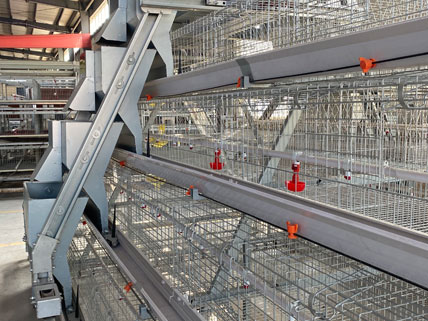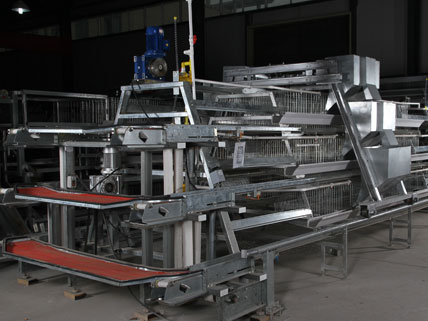The Advantages And Best Practices Of Slatted Floor Systems In Poultry Farming
The use of appropriate flooring systems is a crucial aspect of modern poultry farming practices. Among the various flooring options available, the slatted floor system has gained popularity for its unique characteristics and benefits. In this article, we will explore the slatted floor system in poultry farming, its definition, and the purpose and benefits it offers to poultry producers.
What Is The Slatted Floor System?
The slatted floor system in poultry farming refers to a flooring structure composed of evenly spaced, parallel slats or bars that form the surface on which the birds walk and rest. Typically, these slats are constructed from materials like plastic, metal, or concrete. They have spaces or openings between them that permit trash to fall through the floor. Based on the size of the birds and the particular needs of the poultry operation, the spacing and size of the slats are carefully chosen.
Slatted floors have shown to be a useful flooring solution for poultry houses, providing many advantages to both poultry farmers and the animals.
Slatted Floor Systems Overview
The design and materials used in slatted floors
Slatted floors in poultry farming are engineered flooring systems designed with a series of parallel slats or bars that form the surface on which the birds walk and rest. These slats are typically made of various materials, including plastic, metal, or concrete, depending on factors such as cost, durability, and ease of cleaning. The chicken house's slats are uniformly placed to allow waste to fall through and to promote efficient waste management and hygiene. The spaces between the slats are purposefully created to strike a delicate balance between offering the birds appropriate support and allowing for the easy passage of waste.
The materials commonly used for slatted floors
Plastic slatted floors:
Plastic slats are a prevalent choice for poultry cultivating due to their toughness, ease of cleaning, and cost-effectiveness. They are regularly made from high-density polyethylene (HDPE) or polypropylene (PP), which offer amazing resistance to erosion, chemicals, and the cruel conditions of poultry houses. Plastic supports are lightweight, making them less demanding to handle amid establishment and upkeep. They too give great warm separator and offer a comfortable surface for the birds.
Metal slatted floors:
Metal braces, regularly made of galvanized steel or aluminum, are known for their quality and life span. They give fabulous bolster for the fowls and are safe to wear and tear. Metal supports are generally simple to clean and keep up, but they may require extra separator to avoid warm exchange, as metal can gotten to be too much hot or cold depending on the natural conditions. Care ought to be taken to guarantee the edges of metal supports are adjusted or smooth to anticipate wounds to the birds` feet.
Concrete slatted floors:
Concrete braces offer solidness and quality, making them appropriate for heavy-duty applications. They are ordinarily precast with strengthened steel for included quality. Concrete braces give a steady and durable surface for the feathered creatures and are safe to harm from scratching or pecking. In any case, they may require extra cover to avoid the exchange of extraordinary temperatures and can be more challenging to clean compared to plastic or metal slats.
The dispersing and measurements of slats
The dividing and measurements of braces in poultry cultivating depend on variables such as the measure and weight of the winged creatures, squander administration prerequisites, and industry guidelines. By and large, the crevices between the supports run from 10 to 30 mm (0.4 to 1.2 inches) to permit for the section of squander materials.The width of the slats varies depending on the specific application, but it is typically between 50 and 100 mm (2 to 4 inches) to provide adequate support for the birds.
The spacing between slats should be carefully considered to strike a balance between waste management efficiency and the prevention of foot-related issues. If the gaps are too wide, there is a risk of footpad lesions or leg problems in the birds. Conversely, if the gaps are too narrow, waste removal may be hindered, leading to hygiene issues. The spacing and dimensions of slats should be determined based on the specific requirements of the poultry operation and the size of the birds being housed.
Advantages And Disadvantages Of Slatted Floor Systems In Poultry Farming
Advantages
Efficient waste management and improved hygiene within the poultry house:
Slatted floor systems allow for the effective removal of waste, preventing direct contact between birds and waste materials. This minimizes the build-up of organic matter, reduces the risk of bacterial contamination, and promotes a cleaner and healthier environment for the birds.
Better air quality and reduced ammonia levels, enhancing the respiratory health of the birds:
By separating the birds from their waste, slatted floor systems help maintain healthier air quality within the poultry house. This reduces the concentration of ammonia, which can negatively impact the birds' respiratory health. Improved air quality contributes to better overall welfare and performance.
Ease of cleaning and maintenance, saving time and effort for poultry farmers:
Slatted floors are relatively easy to clean and maintain compared to other flooring systems. The gaps between the slats allow for efficient waste removal, simplifying the cleaning process. This saves time and effort for poultry farmers, enabling them to focus on other essential aspects of flock management.
Enhanced biosecurity, reducing the risk of disease transmission:
Slatted floor systems contribute to improved biosecurity measures in poultry farming. With efficient waste management and reduced contact between birds and waste, the risk of disease transmission is minimized. This helps safeguard the overall health and productivity of the flock.
Comfortable surface for the birds to walk and rest on, minimizing footpad lesions:
Well-designed slatted floors provide a comfortable surface for the birds to walk and rest on. They offer sufficient support, reducing the risk of footpad lesions and leg problems. A comfortable environment promotes better mobility, encourages natural behaviors, and enhances the overall welfare of the birds.
Disadvantages
Potential discomfort and limitations in natural behaviors:
Slatted floor systems, if not properly designed or maintained, may cause discomfort for the birds. The gaps between the slats can be challenging to walk on, limiting certain natural behaviors such as dust bathing and foraging. Ensuring optimal design and providing additional environmental enrichment can help mitigate these limitations.
Initial installation costs:
The initial installation of slatted floor systems may involve higher costs compared to traditional flooring options. However, considering their long-term benefits and durability, the investment can be worthwhile for poultry farmers.
Regular maintenance and monitoring requirements:
Slatted floors require regular cleaning, maintenance, and monitoring to ensure their functionality and prevent any welfare issues. This includes inspecting for damaged slats, maintaining proper waste removal, and monitoring the birds' health and behavior. Adequate resources and time should be allocated for these tasks.
Despite these considerations, the advantages of slatted floor systems in poultry farming, such as efficient waste management, improved hygiene, and enhanced welfare, often outweigh the disadvantages. With proper design, maintenance, and management, slatted floor systems can significantly contribute to the success and sustainability of poultry operations.
Management Practices and Recommendations
Optimal slat design
Spacing:
The spacing between slats should be carefully determined based on the size and age of the birds, waste management requirements, and animal welfare considerations. The gaps should be wide enough to allow for efficient waste removal but narrow enough to prevent footpad lesions and leg problems. Generally, a spacing range of 10 to 30 mm (0.4 to 1.2 inches) is recommended.
Width:
The width of the slats is also an important factor to consider. The slats should be wide enough to provide sufficient support for the birds, preventing discomfort and leg issues. Typically, a width between 50 and 100 mm (2 to 4 inches) is appropriate for most poultry species.
Bedding options and their impact on animal comfort and health
Deep litter systems:
In some cases, poultry producers may choose to incorporate a deep litter system alongside slatted floors. This involves placing a layer of absorbent material, such as wood shavings or straw, on the slatted floor. Deep litter systems offer additional comfort for the birds, providing a soft and cushioned surface to walk and rest on. The bedding material absorbs moisture, reduces odor, and promotes natural behaviors like scratching and dust bathing. However, proper management is crucial to ensure that the litter remains dry, clean, and well-maintained.
Plastic or rubber mats:
Another option is to place plastic or rubber mats on the slatted floor. These mats provide a comfortable and slip-resistant surface for the birds. They can help reduce footpad lesions and provide insulation against extreme temperatures. Regular cleaning and disinfection of the mats are necessary to maintain optimal hygiene.
Regular cleaning, maintenance, and monitoring of slatted floors
Cleaning:
Regular cleaning of slatted floors is crucial to maintain hygiene and prevent the build-up of waste materials. Mechanical scraping or flushing systems can be employed to remove accumulated waste that has fallen through the slats. It is important to remove the waste promptly to prevent ammonia production and reduce the risk of disease transmission. Regular cleaning also includes the removal of any accumulated dust, feathers, or debris from the slats and the surrounding areas.
Maintenance:
Proper maintenance of the slatted floor system is essential to ensure its functionality and durability. Regular inspections should be conducted to identify any damaged or broken slats, sharp edges, or structural issues. Any damaged components should be repaired or replaced promptly to prevent injury to the birds and maintain a safe and comfortable environment.
Monitoring:
Regular monitoring of the slatted floor system and the birds' behavior is crucial for early detection of any welfare or health issues. Observation of the birds' gait, foot condition, and overall behavior can help identify any signs of discomfort, lameness, or stress. Monitoring the waste removal efficiency and waste management process is also important to ensure the system is functioning optimally.
By implementing regular cleaning, maintenance, and monitoring practices, poultry producers can ensure the longevity and functionality of the slatted floor system while promoting the welfare and health of the birds. Proper management of the flooring system contributes to a clean, comfortable, and hygienic environment for the birds, ultimately enhancing their overall productivity and well-being
Conclusion
In conclusion, slatted floor systems offer numerous benefits in poultry farming, particularly in waste management and hygiene. They facilitate efficient waste removal, reducing direct contact between birds and waste materials. This, in turn, improves hygiene conditions, minimizes disease transmission, and enhances air quality within the poultry house. However, it is essential to consider animal welfare aspects associated with slatted floors, such as surface comfort and potential foot and leg problems. Optimal slat design, including spacing and width considerations, plays a crucial role in ensuring the birds' comfort and well-being.
To achieve optimal results with slatted floor systems in poultry farming, proper design, maintenance, and management are paramount. It is important to carefully determine the spacing and width of the slats to strike a balance between waste removal efficiency and animal welfare. Regular cleaning and maintenance are essential to prevent the build-up of waste and ensure a hygienic environment. Monitoring the birds' welfare and behavior helps identify and address any issues promptly.
Furthermore, providing additional environmental enrichment and considering bedding options, such as deep litter systems or plastic/rubber mats, can enhance animal comfort and welfare. The overall success of a poultry operation relies on the integration of proper design, regular maintenance, and attentive management practices to create a clean, comfortable, and healthy environment for the birds.
By following these guidelines, poultry producers can optimize the benefits of slatted floor systems, promoting efficient waste management, improved hygiene, and enhanced animal welfare. Ultimately, this contributes to the productivity, profitability, and sustainability of poultry farming operations.

 Rre
Rre







Post your divine reply